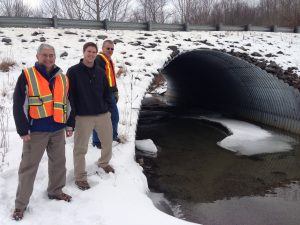The New Normal: Culverts in Maine Stressed to the Limit
 The culverts that snake beneath the streets, driveways and fields of Maine’s coastal towns were built to handle the normal load of water dumped on the state each year, the same amount communities had offloaded for years. But today there’s a problem.
The culverts that snake beneath the streets, driveways and fields of Maine’s coastal towns were built to handle the normal load of water dumped on the state each year, the same amount communities had offloaded for years. But today there’s a problem.
There’s a new normal.
A recent review of statewide data by Sustainability Solutions Initiative (SSI) researchers has shown that increases in both precipitation and storm severity over the past 10 years have damaged and destroyed culverts meant to last decades longer. In analyzing the data, researchers on SSI’s Coastal Adaptation team, who are working closely with Midcoast-area communities, found that the culverts simply can’t handle the increased run-off. And the problem is expected to intensify in coming years. Fixing it will be tough. Though Maine as a whole throws millions of dollars at stopgap repairs each year, roadblocks to improved infrastructure are numerous. Depending upon where they are located, culverts may be owned and governed by local, county, state or federal entities. Many are on private land. Yet there are no agreed upon engineering or maintenance standards and little to no coordination between governing bodies.
Compounding the problem is the fact that municipalities and engineering firms often use outdated data to design and install culverts. Solutions will require a new level of coordination and partnership between these many different groups, or stakeholders. SSI researchers say a sustainable future depends on it: “These are real world dealings. If you want to solve the problem, you have to understand that this is a complex puzzle, that there are multi-linked pieces that need to be understood. It requires investment in our stakeholders. We have to find a way to see eye to eye, to have mutual understanding of scientific information within the context of real world issues and financial realities,” said Shaleen Jain, Assistant Professor of Civil and Environmental Engineering, co-leader of the Coastal Adaptation team with Esperanza Stancioff, Associate Extension Professor at University of Maine Cooperative Extension and Maine Sea Grant Program.
“This is novel. We are doing things differently than they’ve been done before,” Stancioff said. “We have held several community meetings to discuss issues and to co-develop resources and tools. This is the intersection of the economic, social and environmental, the essence of the sustainability approach.”
Some of the biggest problems stem from outdated architecture. Researchers on the Coastal Adaptation team found that many engineering firms still design culverts using precipitation data gathered in the 1960s. According to those predictions, a major precipitation event like a hurricane or tropical storm could be expected once every 50 years, researchers said. New data shows these kinds of storms are now predicted to hit every 12 years. This new information coincides with a rash of severe culvert damage reported around the state.
“There is currently no established method for managing storm water in a changing climate,” said team researcher Alex Gray. “There are no studies on costs versus benefits. There are few detailed city records on repairs. And there is no truly reliable prediction model of precipitation.”
Gray and his colleagues have worked with stakeholders in two coastal municipalities: Ellsworth and Lincolnville. Both municipalities reported high rates of culvert damage and replacement in recent years. Before suggesting ideas, Jain, Gray and their team met with officials and citizens in both towns, a move which goes to the heart of SSI’s grounding principle of equal partnerships. One solution, in other words, does not fit all. Researchers found that each municipality wanted something different. While Ellsworth was interested in a long-term engineering/planning approach, Lincolnville was keen on a less technical, easy-to-implement solution.
Right now, Ellsworth is working toward a multi-year storm water plan. Armed with new information from researchers, city officials and citizens are on the cusp of important decisions such as the mapping of culvert infrastructure and changes in engineering strategy. Jain said the team hopes to continue to support Ellsworth with advanced weather modeling and education.
Lincolnville has taken a straightforward approach, one that is likely to be realistic for a majority of Maine towns, which don’t have large budgets for engineering. The bottomline: If you’ve replaced a culvert twice in the same place, put in a bigger one next time.
“If you’ve had to replace an 18-inch culvert twice over the last few years, put in a 24-inch culvert instead. It’s not perfect science, but it’s a real world solution,” Gray said.
Work in the near future is focused on the creation of a statewide culvert map, a massive project that would attempt to document the hundreds of thousands of culverts in the state for use in future management and planning.
Said Gray: “This is uncharted territory.”
Supported by National Science Foundation award EPS-0904155 to Maine EPSCoR at the University of Maine.
______________________
To see the Coastal Adaptation team in action, watch “Culvert Operations”, a documentary in the Sustainable Maine series, a shared initiative of The Mitchell Center’s Sustainability Solutions Initiative and Maine EPSCoR in collaboration with MPBN.
Get more information on the Coastal Adaptation team.
